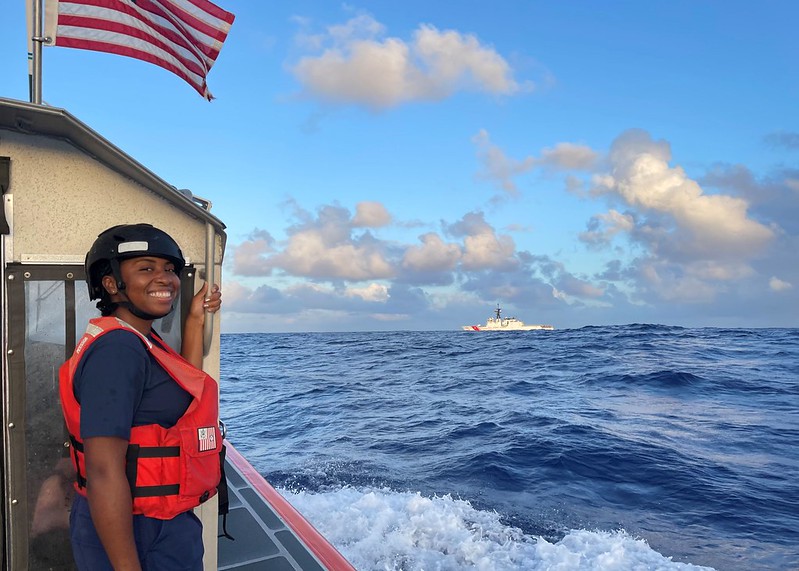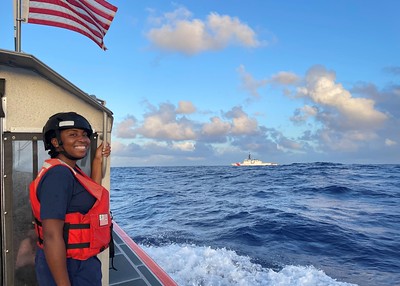Shiprider Agreements Making Headway

U.S. Coast Guard photo courtesy of the Coast Guard Cutter Kimball. CC BY-NC-ND 2.0 DEED
On February 23, a U.S. Coast Guard (USCG) press release touted the successes of a shiprider patrol of Kiribati’s Exclusive Economic Zone (EEZ), as part of “Operation Blue Pacific.” This is only the latest iteration in a series of shiprider patrols undertaken by the USCG and, more occasionally, the U.S. Navy. Bilateral shiprider agreements allow host-nation maritime law enforcement officers to embark aboard select USCG assets during transits of their EEZ’s. These joint teams then work together to extend and enforce the sovereign reach of the host nation in protecting itself against illicit transnational maritime activity, by allowing those officers the ability to deputize the U.S. commander and crew for the purpose of stopping, inspecting, and/or detaining vessels suspected of violating laws or regulations — chiefly, but not exclusively, those prohibiting illegal, unreported, and unregulated (IUU) fishing.
U.S. media coverage of Operation Blue Pacific largely focused on the reported boarding by the USCGC Oliver Henry of two fishing vessels flagged to the People’s Republic of China (PRC), stirring various concerns by some Americans that their Coast Guard is “poking the dragon,” “serving as game wardens in the South China Sea,” or “spending too much time overseas instead of protecting the U.S. coastline.” In fact, the boardings were routine and led to no reported concerns. They were conducted in the Central Pacific, thousands of miles away from the contested waters of the South China Sea. And the Coast Guard has thousands of miles of coastline to patrol in the Pacific, including: the State of Hawaii; the unincorporated U.S. territories of American Samoa, the Commonwealth of the Northern Mariana Islands, Guam, and the U.S. Minor Outlying Islands; and the Freely Associated States (FAS), comprised of the Federated States of Micronesia, the Republic of the Marshall Islands, and the Republic of Palau. The FAS are independent, sovereign nations that have chosen to cede all defense responsibilities to the United States.
The shiprider program is regarded by the Coast Guard and U.S. Navy as the flagship of Theater Security Cooperation (TSC), a kind of military diplomacy that is itself the cornerstone of sustained U.S. engagement with Pacific Island partners. In the course of my own years engaged in foreign policy statecraft in the Pacific, I came to see the U.S. Peace Corps and TSC as the most impressive and effective tools in our diplomatic toolbox. That TSC is best exemplified by the U.S. Navy’s annual Pacific Partnership deployments, the Engineering Civic Action Programs conducted by U.S. Navy Seabees, maritime search and rescue operations conducted by U.S. Coast Guard Forces Micronesia/ Sector Guam, and the USCG’s shiprider maritime law enforcement (MLE) program.
The genesis of the shiprider program was the principle enshrined in Article VI of the Niue Treaty on Cooperation in Fisheries Surveillance and Law Enforcement in the South Pacific, signed in Honiara in 1992. This provision stipulated that any party to a subsidiary agreement could permit a second party to extend its fisheries surveillance and law enforcement activities to the territorial sea and archipelagic waters of the first party.
The shiprider program began with a bilateral agreement between Washington and Avarua in 2008. I was not involved in this agreement with Cook Islands, but over the next few years I did become modestly involved in the negotiation of six shiprider agreements across the Pacific. My dear mentor, the late Ambassador C. Steven McGann–an affiliate of CANZPS who passed away last May–had a greater hand in negotiating all six and at least three more. U.S. Coast Guard District 14 in Honolulu has entered into no fewer than 12 shiprider agreements with Pacific Island countries (PICs): Cook Islands, Fiji, Kiribati, Marshall Islands, Micronesia, Nauru, Palau, Papua New Guinea, Samoa, Tonga, Tuvalu, and Vanuatu.
During the memorable Pacific Partnership 2009 deployment in Tarawa, I briefed then-Commander, Pacific Fleet ADM Robert Willard regarding the Coast Guard’s shiprider program. He immediately grasped its effectiveness and formulated the Navy’s nearly identical Oceania Maritime Security Initiative (OMSI) when he was elevated to lead U.S. Pacific Command. OMSI is a Secretary of Defense program that enables USCG personnel and host-nation MLE officers to conduct surveillance and interdiction operations from U.S. Navy assets in coordination with the Western and Central Pacific Fisheries Commission headquartered in Pohnpei, FSM.
In October 2022, Washington and Palikir signed an innovative new expanded shiprider agreement. For the first time, the United States would be allowed to act on behalf of the FSM in combating illicit maritime activity in its EEZ even when an FSM officer is not present. The new arrangement allows for the FSM National Police to provide the U.S. Coast Guard with remote authorization through coordination between U.S. and FSM command centers. Palau has since signed onto a similar expanded program.
The successes of Operation Blue Pacific notwithstanding, Kiribati’s greatest success with the shiprider program came in its maiden operation with the USCG in August 2009, when it assessed approximately million in fines against a fishing company for unlicensed fishing near Kiritimati Island in the Northern Line Islands. Such a sum is a budgetary windfall to a small PIC. After defraying related police expenses, the rest of the proceeds go to a trust fund established by Tarawa to finance the operation of Kiribati’s lone Pacific Patrol Boat, which Australia plans to augment with a second boat later this year.
I lead a Micronesia-based not-for-profit corporation, Partnership for the Environmental Protection of the Pacific (P℮PP), which has proposed creation of a virtual All-Micronesia coast guard we call “NAVATARS,” short for Naval Auxiliary Transport, Asset Recovery, and Search. An All-Micronesia Coast Guard is an item that has been on the Micronesian Chief Executive Summit agenda for several years. This public-private initiative would build on the shiprider concept by deploying a private maritime security force, under PePP’s administration, across multiple EEZs, sustaining itself through international donations and a percentage of the revenue it brings to subscribing governments. NAVATARS needs the donation of three patrol boats before it can launch.
The USCG’s shiprider program in the Caribbean has somewhat foundered over drug interdiction policy, but its Pacific shiprider program continues gathering wind. Papua New Guinea is the latest country to sign onto shiprider (May 2023). A shiprider agreement has been proposed for Niue. Solomon Islands remains a holdout and instead has strengthened its police and security relations with the PRC.
The PRC is increasingly concerned that the USCG’s shiprider program will be extended to the Philippines and/or Vietnam, both counterclaimants to the PRC in the territorial dispute in the South China Sea. Chinese analysts have recommended that Beijing sign its own shiprider agreements with South China Sea coastal states – a reminder that imitation is the sincerest form of flattery.
The USCG undoubtedly can be useful in countering Beijing’s “Maritime Gray Zone operations” in the region, but, especially in light of the PRC’s January 2021 adoption of the Coast Guard Law authorizing use of force against foreign vessels, the United States would do well to expand its mil-mil cooperation with regional partners before prematurely placing the USCG in a vulnerable position patrolling overlapping EEZs.
